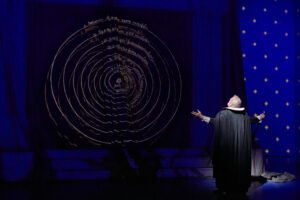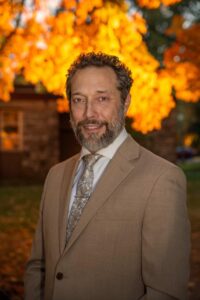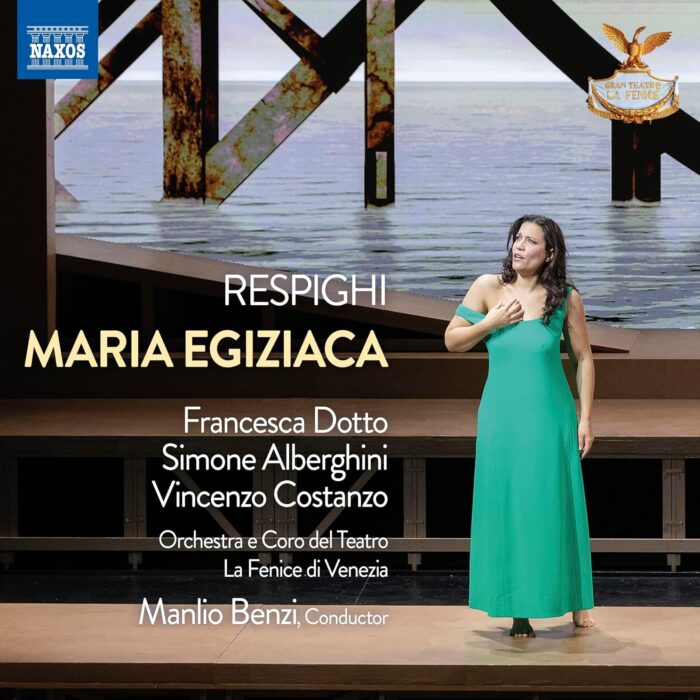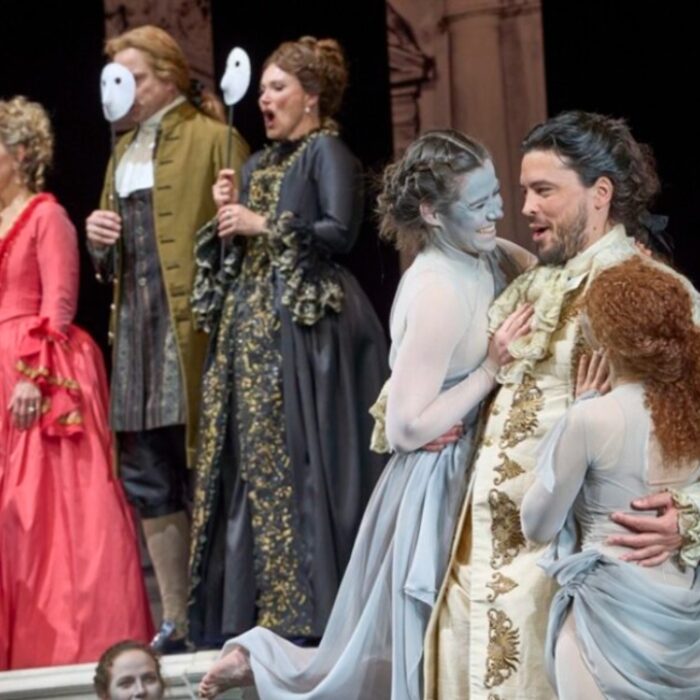
Opera Theatre Saint Louis 2024 Review: Galileo Galilei
OTSL makes powerful case for Philip Glass’ rarely performed ‘Galileo Galilei’
By Benjamin Torbert(Photo Credit: Eric Woolsey)
Opera Theatre Saint Louis cultivates a justly deserved reputation for promoting contemporary works, having world-premiered 40-some operas in the company’s five decades, and staging many other operas born after WWII but perhaps not new enough to be labeled “contemporary” in 2024.
The American legend, Philip Glass, made one prior appearance at the company—in person then, too—with the US premiere (2017) of “The Trial,” a somewhat eccentric outlier in his oeuvre, eccentricity one might expect for an opera based on a text by Franz Kafka. While interesting, “The Trial” was surpassed by OTSL’s second outing with Glass this year, his little-performed “Galileo Galilei” (2002), previously performed only at its premiere in Chicago at the Goodman Theater, in Cincinnati, and Portland, the last fortunately committed to compact disc. The company reported that they substituted “Galileo” relatively late in their planning process due to the delay of a world premiere—presumably, Ricky Ian Gordon’s “This House,” to appear in 2025. The staging of “Galileo” betrayed no haste in assembly; indeed, Director James Robinson’s production made the most powerful theatrical impact of the four works this season.
Glass’ utterly unmistakable musical language and its cycling arpeggios make adaptable reference to the extramusical world. Hardly anyone evokes water better than Glass (Debussy?), as viewers of the film version of “The Hours” (2002) can attest, the score of which, in the eponymously titled final track, accompanies Virginia Woolf’s aquarian suicide in a transfiguration both characteristically Glassian and reminiscent of Edvard Grieg’s piano concerto. Glass’ water cascades in aural circles, and circles form the primary visual motif in that perfect marriage of music and staging, Phelim McDermott’s landmark “Akhnaten,” unified by Sean Gandini’s choreography of jugglers and that Wieland Wagner-esque Egyptian sun cycling through a spectrum of light. The companion production of “Satyagraha” concludes with a half hour-long set piece linking Gandhi and Martin Luther King Jr, as Gandhi’s “Night song,” a Phrygian scale, asserts the cycling, reincarnative dimensions of truth, of social justice. And just three years ago, Glass’ “Circus Days and Nights” premiered at Malmö Opera—the Latin root of the title word, “circus,” meaning “ring”— a piece about the circus serving as metaphor for the cycle of life. Like Federico Fellini, Glass gravitates towards the circus, and towards figures suspended between earth and sky.
With this circularity, in his best works, Glass creates a world of cognition rooted in the understanding that what you’ve heard and seen constitutes merely one period excerpted from millennia, or an epoch greater than human scale, humans belonging to something far greater than themselves. In Glass, this dynamic calms, even in spirited passages. Imagine Nietzsche’s eternal recurrence, were Nietzsche not such a downer.
Reading is FUNdamental
Opera and its reception chronically suffer from conventional wisdoms grounded in wholesale misreading. To give one famous example, the plot of Verdi’s “Il Trovatore,” oft characterized as hopelessly impenetrable, isn’t remotely complicated, at all. A generation ago, Azucena threw the wrong baby into the fire, hers. She then raised the tenor, the baritone’s brother, as her own child. That’s it, that’s the whole deal. If you want a complicated plot, go watch a Shakespeare comedy.
People grossly misunderstand Glass too, I believe. His ironically repetitive detractors—including a repetiteur at OTSL I’ll not name who gave a pre-performance talk before “Galileo Galilei” —pillory Glass use of repetition. But repetition serves as one of the basic building blocks of art. It structures the New Testament’s basis on the Old Testament. It builds the foundation of Homeric ring composition in the Iliad and the Odyssey. In the various musics labelled “classical,” repetition abounds, in da capo form, in sonata form, and in leitmotif, everybody’s favorite way to link musical figures with extramusical ideas, places, characters, happenstances, nouns in general. Forget Wagner; just listen to most any film score. You’ll hear stuff multiple times. Pop songs repeat the chorus, Hip-Hop songs the hook. And without repetition, rhythm itself doesn’t exist. Disdaining repetition makes about as much sense as disdaining pitch, and Glass uses it far more productively than his opponents credit him for. I derive my understanding of why people deem his use of repetition a problem from the New Formalist literary critic, Dr Caroline Levine: “Modernity is in thrall to innovation.” Levine identifies how, especially since Romanticism, western art has fetishized rupture and [purportedly] radical innovation; critics value the creation of something allegedly novel far more than they do the artist refreshing forms in a meditative fashion.
Levine’s comments on gender and repetition can help us understand Glass too; Glass’ repetition generates, echoing the feminine power of lifegiving. Even if only subconsciously, people resist when they deem a male artist insufficiently masculine. Glass’ waters and spheres communicate something feminine-gendered, and women create both art and life. A second old saw visited upon Glass besides “monotonous” is the broader descriptor that ill fits him but claims to situate him somehow in a larger artistic movement, “minimalism.” His operas cannot be accurately categorized as minimal any which way. Karen Kamensek, who conducted “Akhnaten” in its Met outings fired back at this misnomer, calling instead his trademark compositional style “additive.” One has only to listen to the prelude of “Akhnaten” in order to grasp her description, as each orchestral voice rises out of the Nile River valley, like life itself, and eventually building and building like the city Akhnaten will commission in the desert, assembled by people, every one of woman born.
And still I say, it turns
Who better, then, than Philip Glass to gift us an opera concerned with spheres terrestrial and celestial, and the relation between them? I’ll argue for “Galileo Galilei” as one of his most successful operas, not only because his musical idiom perfectly suits the story, but because the social dimensions of that story engage in a conversation that comes back around, and around.
Mary Zimmerman’s libretto gives Glass’ music a wholly effective vehicle for the church’s dispute with Galileo, the contest between dogma and vision. Galileo interrogated a narrower conception of God’s creation, forcibly advanced by retrograde ecclesiastical authorities. And today, anti-Science movements metastasize globally through the amplifying capacity of the internet. The power of human invention astounds, as speedy vaccine development saves hundreds of millions of lives during a pandemic; vaccine uptake stalls as misinformation predates upon anyone with a data connection. Vested interests deem anthropogenic global warming a hoax, and a large fraction of citizens happily concur. Even post-printing press, the Roman Catholic Church of 1633 couldn’t imagine a tool like the internet for countering a Galileo with celerity and comprehensive reach. Conversely, nor could a visionary like him reach as many willing listeners. Hopefully not lost on the audience, OTSL staged this opera in the state of Missouri, where politicians and school boards have launched an expansive campaign of book bans. The events of “Galileo Galilei” belong to the ages, not the narrow timeframe of its setting.
That span unfolds in ten scenes of roughly equal duration arranged in reverse chronology, traveling from older Galileo on house arrest in 1643 regarding his elapsed life and lamenting his lost sight (metaphorically, too), through his recantation in 1633 and trial in 1620, his 1616 writing of the dialogue that got him in trouble, his creation of a telescope in 1610, and finally, to the performance of an opera composed by his father Vincenzo Galilei, setting the Orion myth, in 1572. (Opera fans will point out the pre-Peri, pre-Monteverdi anachronism here; “Galileo Galilei” plays with time imaginatively. Vincenzo, at least, had something to do with the development of recitative). In attendance at the meta-opera both as a child and in his 1642 and 1620 forms, Galileo’s character finds his ocular vision restored.
The world was made so perfectly we only need to look
Galileo, of course, no theological iconoclast, understood his science as a celebration of God’s creation, and this staging of “Galileo Galilei” physicalized that stance with pervasive visual grandeur and beauty. Theatrically, James Robinson’s production melded perfectly the music with the story, aided by Allen Moyer’s impressive sets, Greg Emetaz’s crucial video projections, and Eric Southern’s well-gauged lighting design. On an intermittently rotating turntable set, of course, sat a proscenium, variably purposed as the operatic theater of the finale, and as a “theater” both for the scenes in which the church’s operatives work Galileo over and for a performance of Dialogue Concerning the Two Chief Systems of the World, in a gondola. The proscenium also theatricized Younger Galileo’s conversation with Cardinal Barberini, later to become Pope Urban VIII, and his asynchronous epistolary interaction with his daughter Maria Celeste (Virginia), estranged from him by her entry to a convent and killed by dysentery in 1633.
Most impressively, in the final scene Emetaz authored an explosion of red among the stars, presumably 1572’s Cassiopeian supernova. John Donne referenced this in the poem “An Anatomie of the World.” So bright it could be seen in daytime, and peaking in visibility equivalent to Venus at night, this red dwarf, associated with astronomer Tycho Brahe (and others), exposed “new stars” and destabilized people’s understanding of the “fixed stars,” providing inescapable counterevidence to the Aristotelian system. The visual motif of the Copernican system abounded in OTSL’s staging, in most scenes, but interrupted by lines rather than circles in Galileo’s physics lesson to excitable students in the sixth scene “Inclined Plane / 1613,” a delightful episode of Bill Nye meets Schoolhouse Rock meets Baroque Italy, Glass’ music recalling midcentury’s peppy “Window Gazing” by Ivor Slaney.
Surrounding that, the production team delivered the best visuals of OTSL’s 2024 season. The severe black, midnight blue, and ecclesiastical scarlet of the early—that is, later—scenes gradually admitted a wider palette over the course of the opera, adding light blue, yellow, green, and especially white, the performers of the meta-opera painted in fluorescent alabaster. Indeed, each of the ten scenes included pleasing detail for the eye. Even in a season full of striking costumes at OTSL—not least Constance Hoffman’s parade of elegance for “Julius Caesar”—Marco Piemontese’s for “Galileo Galilei” stood out. Paul Groves’ Older Galileo first appeared in a handsome winged doublet, black velvet with a burnt gold sun embroidered on the back. Sean Plumb’s Younger Galileo wore an Arabian green robe resembling academic regalia. Vanessa Becerra received perhaps the loveliest nun’s habit in history, white, but imprinted with black silhouettes of rising butterflies. Elijah English, Jared Werlein, and Robert Mellon, the three Cardinals cross-examining Galileo, combined in a triptych of cardinal vestments decorated with a single Christian cross spanning their bodies, slanted at a menacing angle. They wore comically tiny sunglasses indoors, emphasizing their lack of imaginative vision. We haven’t space in this review to detail costumes in the meta-opera; suffice it to call it a high Baroque fashion show. Production stills from Portland make clear that OTSL’s staging far exceeded Portland Opera’s in scope, even on the modest thrust stage of the Loreto-Hilton Center.
They sang of heaven and the stars, the sky, the earth, the sun
Maestro Kwame Ryan, in his OTSL debut performances, led a masterful execution of Glass’ deceptively tricky music—the same bon mot that circulates about Mozart does also about Glass, “too easy for the amateur and too difficult for the professional.” Ryan extracted astonishing density and texture from a small band for “Galileo,” with rich textures emerging from the keyboard, and punctuated by another Glassian commonplace, circusy snare drums. Only thirteen instrumentalists populated the orchestra pit, backed by a digital synthesizer, the Saint Louis Symphony’s string section reduced to this night’s concertmaster Celeste Golden Andrews, principal violist Beth Guterman Chu, and associate principal cellist Melissa Brooks. Another virtue of Glass’ musical language is that he can scale the forces required up and down—famously, “Akhnaten” excludes violins, who wouldn’t fit in a modest pit in Stuttgart. So without double basses, the synth provided a driving backing in the second scene, as the Cardinals interrogate Galileo, in a bass voice resembling a digeridoo. More people, in fact, appeared onstage than in the pit; Ryan coordinated all participants precisely, counting their 32s and 64s and what have you. The musicians, therefore, comprehensively integrated the art of math and the art of music and their intersection—astronomy is applied mathematics. The opera’s staffing grows as we travel from Galileo’s dotage to his childhood; the tenth scene, “Finale / 1572” qualifies as a textbook operatic concertato.
Contemporary operas have become more filmic, ensemble-driven, and social, and they mostly eschew something once common, placing a single character onstage for a longish monologue. Ryan’s orchestra began the evening in concert with tenor Paul Groves as older Galileo, isolated, blind, lost in questions about his life and his faith in God. For enthusiasts of the English language, the scene once again recalled seventeenth century literature, here Milton’s sonnet “On his blindness.” Galileo’s science has been his worship of the Lord; now denied permission to engage in scientific inquiry and attenuated by age and ocular injury, he has become one of the spirits in Milton’s closing line: “they also serve who only stand and wait.”
Last night I dreamt I dwelt on the moon
As Older Galileo, Groves gave a sympathetic performance in a role well-suited to his late-career sound, a bit more of a character tenor these days, similar to his vocalism in New York and Chicago recently as Howie, the boxing trainer in Terence Blanchard’s “Champion.” In the reverse chronology of its diegesis, “Galileo Galilei” starts with the protagonist’s sad end and walks him back to childlike wonder at his father’s opera on the Orion myth, the character present in all three ages of life and Older Galileo’s vision restored. Groves’ performance highlighted key questions posed by Mary Zimmerman’s libretto: has God punished him “for trying to read His heavenly book instead of the Book below?” Indeed, Groves wore a Bible on his belt in the second scene when tried by the Cardinals. Galileo observed physical laws of the universe; what are God’s laws? The Cardinals tried him, but does God do so differently? “Am I blind for having knelt and lied / Or for not having knelt long enough?” And what of the scope of Christianity’s sacred texts? In the seventh scene, “A Walk in the Garden / 1612 ” with Cardinal Barberini, Galileo asserts “the Bible is a book about how to go to Heaven, not how the Heavens go.” “Very clever, Galileo,” responds Barberini, but warns him about the unknowability of God and the limited range of the telescope.
Younger Galileo, baritone Sean Michael Plumb, presented an affable man with an insuppressible curiosity, in a voice with a quick vibrato, impressive resonance, and a tahini-colored timbre. Counterbalancing Galileo with both friendliness and subterranean menace even while reassuring him, bass-baritone Hunter Enoch portrayed the Cardinal’s waning compassion, in reverse, as he ascended to the papal seat later in life. Enoch displayed a warm, pine-colored sound, and Plumb deployed a lovely pianissimo with “raised high,” expressing hope in 1612 for his friend’s job prospects. As in Verdi, Glass’ priests appear as antagonists—they assassinate Akhnaten—but Barberini/Urban’s affection for Galileo seemed clear, even while relating his horrific culling of a flock of birds in his garden, for making too much noise. Supernumeraries arrived to pick the doves off a bar and break their necks. As Urban in the second scene, “Recantation / 1633,” Enoch gave resigned authority in contrast to the thirsty vengeance of the three-headed Cardinal, played by baritone Robert Mellon, bass-baritone Jared Werlein, and most furiously, countertenor Elijah English in a brilliant OTSL debut. The Scribe recording this hearing and the fourth scene’s trial, mezzo-soprano Gabriela Linares, had few lines but impressed with a robust, dark sound. The trial and recantation scenes in “Galileo Galilei” accomplished much of what “The Trial” did, with more economy.
Our life is a short dark winter, but it leads to an endless spring
Glass tends to write operas about famous men—Einstein, Gandhi, Columbus, Lincoln, &c— but his operas present with such affection their female characters. Soprano Vanessa Becerra portrayed Galileo’s daughter Maria Celeste (Virginia) with a sweet, agave-colored soprano in a high tessitura, in two heartbreaking scenes, the third, “Pears / 1632,” reading aloud her letter to her father and offering pears from the convent—again, in poetry, a uterine symbol of feminine life-giving. The church took from Galileo not only his freedom but his most beloved offspring. More emotional yet, she carried the eighth scene, “Lamps / 1611,” prior to her nunification, in which Brad Bickhardt’s Priest intoned in Latin as she and her father prayed, Galileo distracted by the pendular rotation of a lamp in the church. As he asserted intelligent design, she bridged his scientific musings back into prayer.
Becerra returned as Eos (Dawn), in the meta-opera finale, in ethereal makeup designed by Krystal Balleza and Will Vicari, soaring over the concertato, and surrounded by chorusmaster Andrew Whitfield’s charges. Flanking her were mezzo-sopranos Lucy Evans as Marie de Medici and Michelle Mariposa as Maria Maddalena, and Kathleen O’Mara as Duchess Christina, all in company debuts. The trio had marveled at Galileo’s optic invention in the penultimate scene. Like Groves’ Galileo, O’Mara’s Christina was doubled by an uncredited child actor viewing the meta-theater; O’Mara delivered the closing of Orion’s story as his sight is restored and he joins Eos in marriage. In an opera concerned so centrally with sight, the entire company dazzled the eye in the finale, unifying all elements of opera, sonic and visual, backed by paintings of the Orion story and that disconcerting supernova. Though triumphant and transformative, the finale recalled Older Galileo’s early (late) question in the opening scene: “All those years I looked so hard— / as hard as I could— / at the lessons of the stars above / missing the lessons below.”
The human mind is a work of God and one of the best of all
“Galileo Galilei” bids the listener to consider the long-term reputation and legacy of Glass, now in his late 80s. A testament to his versatility in genre, that there’s a conversation to have here: what will Glass be most known for a century from now? Will it be the film scores, especially those for “Koyaanisqatsi,” “The Truman Show,” and “The Hours?” Will it be the chamber arrangements of “Glassworks” and other pieces for chamber strings or solo keyboards, like “Mad Rush?” Or will his reputation stand principally on his operas? Perhaps the best answer is none of the above, but rather his distinctive musical language that unites each of his projects in distinct genres. What a miracle that an artist with a consistent, idiosyncratic sound can adapt it to so many realms of human experience. But there’s something inherently theatrical about Glass, and opera will lose measurably if his best ones don’t enter the long-term canon. The duration of “Galileo,” about eighty minutes, too long for a double bill but not quite long enough to make an evening, recalls some fantastic works that have departed the standard rep for that reason, such as Montemezzi’s “L’amore dei Tre Re.”
But our attention spans have shrunk and that may be a lesser handicap in this century than the last. OTSL made a powerful case for repeated revival of this opera, so intelligently integrated in topic, themes, music, and stagecraft, and hopefully it will take its place alongside more-performed works like “Akhnaten” and “Satyagraha.” Glass is a treasure, and we’re so lucky he dwells with us yet.



